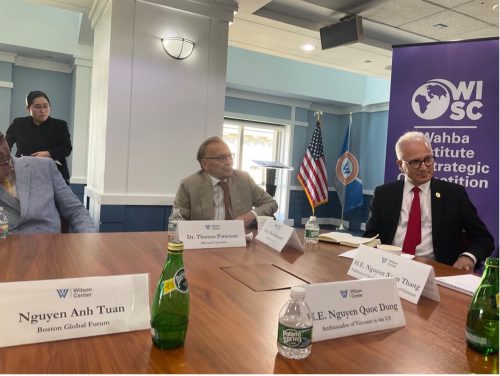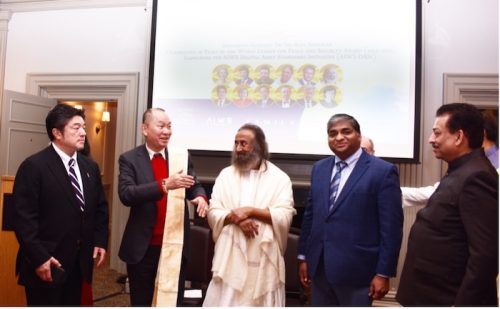Preface
Advances in AI, Internet, social media, and threats to cybersecurity jointly shape a new worldwide ecosystem for which there is no precedent. At issue is building new dimensions, even principles, which would shape the future of international law. Toward this end, the Social Contract 2020 has been introduced, framed, and further refined in four contexts: (a) The Riga Conference, Oct 12, 2019, (b) “2019 Policy Dialogue on Artificial Intelligence” of World Leadership Alliance-Club de Madrid, Oct 21, 2019, (c) AI World Society – Summit 2020 at Loeb House, Harvard University, April 28, 2020, and (d) United Nations Charter Day, June 26, 2020.

Co-founder of the AIWS Innovation Network
I. INTRODUCTION – NEW GLOBAL ECOLOGY
The term “artificial intelligence” refers to the theory and development of computer systems able to perform tasks that normally require human intelligence, such as visual perception, speech recognition, decision-making, translation between languages, self-driving cars, and so forth. Almost everyone recognizes that advances in AI have already altered conventional ways of viewing the world around us. This is creating new realities for everyone – as well as new possibilities.
These advances are powerful in many ways. They have created a new global ecology; yet they remain opaque and must be better understood. We have created new tradeoffs that must be assessed. We must now focus on critical principles and essential supporting practices for the new and emerging Social Contract 2020.
We must now re-think and consolidate the best practices for human development, recognizing the power and the value of the individual and of society.
II. NEW REALITY – AND NEW UNKOWNS
Advances in AI are far more rapid that we appreciate. Fully understanding the scale of the AI domain remains elusive. We have seen a shift from executing instructions by humans to replicating humans, outperforming humans, and transcending humans.
We are at the beginning of a new era, a world of mind-machine convergence with biological drivers for both mind and machine. Also elusive is the management of embedded insecurities in applications of this new ubiquitous technology and the imperatives of safety and security.
When all is said done, AI remains: devoid of consciousness, empathy, and perhaps select other human features, such as ethics, so fundamental to humanity and the social order. Its current logic is situated at the frontiers of biological intelligence and machine intelligence. While it is generally anchored in past data, it has made possible whole new sources and forms of design space.
In sum: The world of AI today is framed by a set of unknowns — known unknowns and unknown unknowns — where technological innovation interacts with the potential for a total loss of human control.
III. INTERNATIONAL CONSENSUS
There is a clear awareness in the international community of the challenges and opportunities, as well as the problems and perils of AI, and many are seeking ways of managing their approach to AI. At least 20 countries have announced formal strategies to promote the use and development of AI. No two strategies are alike, however there are common themes even among countries who focus on different aspects of AI policy. The most common themes addressed pertain to:
- Scientific research,
- Talent development,
- Skills and education,
- Public and private sector adoption,
- Ethics and inclusion,
- Standards and regulations, and
- Data and digital infrastructure.
Concurrently, AI is becoming a focus for foreign policy and international cooperation – for both developed and developing states. There is a shared view that no country will be able to compete or meet the needs of its citizens without substantial AI capability.
More important, many countries are now involved in technology leapfrogging rather than in replicating known trajectories of the past century. It is no longer expected, nor is it necessary, to replicate the stages of economic development of the west —one phase at a time. Countries now frame their own priorities and strategies.
In sum, all countries are going through a common experience of adapting to and managing unknowns. This commonality of shared elements result in a welcoming international atmosphere for a Social Contract 2020. What is the Social Contract 2020?
IV. FOUNDATIONS and PRINCIPLES
There is a long tradition of consensus-based social order founded on cohesion and not use of force nor formal regulation or legislation. It is a necessary precursor for managing change and responding to societal needs.
The foundational questions are: what, why, why and how?
What?
A social contract is about supporting a course of action. It is inclusive and equitable. It focuses on the relationships among people, governments, and other key entities in society.
Why?
To articulate the concerns and find common convergences. And to frame ways of addressing and managing potential threats.
Who?
In today’s world, participants in the Social Contract 2020 involve:
- Individuals as citizens and members of a community
- Governments who execute citizen goals
- Corporate and private entities whose operations involve
Business rights and responsibilities
- Civil society that transcends the above
- Innovators of AI and related technologies, and
- Analysts of ethics and responsibility. None of the above can be “left out.”
Each of these constitutes a distinct center of power and influence.
How?
The starting point consists of three foundational principles for powerful international cooperation that provide solid anchors for the Social Contract 2020:
(1) Precautionary Principle for Innovations and Applications:
The precautionary principle is well established internationally. It does not impede innovation, but supports it. It does not push for regulation, but supports initiatives to explore the unknown with care and caution.
(2) Fairness and Justice for All
The second principle is already agreed upon in the international community as a powerful aspiration. It is the expectation of all entities – private and public — to treat, and be treated, with fairness and justice.
(3) Responsibility and accountability for policy and decision – private and public
The third principle recognizes the power of the new global ecology that will increasingly span all entities worldwide — private and public, developing and developed.
Jointly, these basic foundations – what, why, who and how – create powerful anchors for framing and implementing the Social Contract 2020.
V. SOCIAL CONTRACT 2020
All participants and centers of power and influence contribute to framing the legal order in the age of AI. And each has rights and responsibilities that must be articulated and respected. An initial framing is presented below:
(1) Individuals, Citizens, Groups:
Everyone is entitled to basic rights and dignity that are enhanced (?) by AI and the Internet Age and entail greater responsibility:
Data Rights and Responsibilities
Each individual has a right to privacy and is entitled to a device to access and control their own data. Individuals have a right to organize ways of managing their data, individually or collectively.
Education and Political Participation
Each individual has the Right to be involved directly and effectively in political decisions. Each has access to education/knowledge pertaining to the use and impact of AI.
Responsibility:
Each individual is prohibited from exercising adverse behaviors, such as hacking and disseminating disinformation.
(2) Governments:
Every government is expected to behave responsibly in the management of AI for governance and for interactions with individuals.
Governments Standards:
- Create incentives for citizens to use AI in ways that benefit society.
United Nations and International Organizations:
- Extend sphere to include AI and extend the upholding of international standards/norms/practices pertaining thereto.
- Create and manage a universal digital currency.
(3) Business Entities
Business operations and related rights come with accountability and responsibility – nationally and internationally.
- Respect independent audits for fairness, accountability, and cybersecurity.
- Respect common AI values, standards, norms, and data ownership rules, and expect penalties for noncompliance.
(4) Civil Society Organizations:
Rights and responsibilities of civil society organizations include monitoring governments and firms with respect to common values.
- Civil society organizations are responsible for compliance with common values/norms/standards/laws and expect penalties for noncompliance.
- Support and recognize exemplary citizen contributions in AI area.
(5) AI Assistants:
AI assistants provide an interface to facilitate compliance with established standards.
- Support AI users and assist them to serve the broad interests of society.
- Engage with other power centers for mutual support and supervision.
VI. PREFERENCES and PERFORMANCE
The Social Contract 2020 consists of general principles and directives for its implementation. Each country is different, as would be the approach to the implementation and adoption of Social Contract 2020. These preferences are often in the nature of tradeoffs at the intersection of AI and society. These are simply adjustment mechanisms to facilitate implementation of Social Contract 2020. For example:
- Performance & explicability
- Ethics & efficiency
- Growth & sustainability
- Convenience vs. safety
- Power & accountability
- Regulation & innovation
- Security vs. stability
Social Contract 2020 helps steer societies to transcend current practices and forms of e-government by enabling and providing applications of AI to assist decision making for all critical functions – notably the provision of public services, performance of civic functions, and evaluation of public officials – supported by a Center for National Decision Making and Data (NDMD).
AI supported public services span major critical functions to enable automated public services assisted by AI, notably:
- Health care and public health:
Build AI hospitals for remote, rural, and mountainous areas.
- Education:
Build AI schools for remote, rural, and mountainous areas.
- Law, legal services:
Build AI law, legal services.
- Public transportation:
AI public transportation information and support system.
- Public services for tourism:
AI public services for tourism.
- Public services to support labors:
AI labor, job guidance system.










